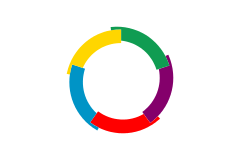Seychelles
Seychelles (/seɪˈʃɛlz/ (![]()
Republic of Seychelles
| |
|---|---|
Motto: "Finis Coronat Opus" (Latin) "The End Crowns the Work" | |
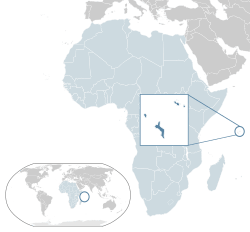 Location of Seychelles (dark blue) – in Africa (light blue & dark grey) | |
| Capital and largest city | Victoria 4°37′S 55°27′E |
| Official languages | |
| Ethnic groups |
|
| Religion |
|
| Demonym(s) |
|
| Government | Unitary presidential republic |
| Danny Faure | |
| Vincent Mériton | |
| Nicholas Prea | |
| Legislature | National Assembly |
| Independence | |
• from the United Kingdom | 29 June 1976 |
| Area | |
• Total | 459 km2 (177 sq mi) (181st) |
• Water (%) | negligible |
| Population | |
• 2018 estimate | 97,096[2][3] (200th) |
• Density | 205.3/km2 (531.7/sq mi) (67th) |
| GDP (PPP) | 2018 estimate |
• Total | $2.919 billion[4] |
• Per capita | $30,486[4] |
| GDP (nominal) | 2019 estimate |
• Total | $1.564 billion[4] |
• Per capita | $16,332[4] |
| Gini (2013) | 46.8[5] high |
| HDI (2018) | very high · 62nd |
| Currency | Seychellois rupee (SCR) |
| Time zone | UTC+4 (SCT) |
| UTC+4 (not observed) | |
| Driving side | left |
| Calling code | +248 |
| ISO 3166 code | SC |
| Internet TLD | .sc |
Seychelles was uninhabited prior to being encountered by Europeans in the 16th century. It faced competing French and British interests until coming under full British control in the late 19th century. Since proclaiming independence from the United Kingdom in 1976, Seychelles has developed from a largely agricultural society to a market-based diversified economy, characterized by rapidly rising service, public sector, and tourism activities. From 1976 until 2015, nominal GDP grew nearly sevenfold, and purchasing power parity increased nearly sixteenfold. Since the late 2010s, the government has taken steps to encourage foreign investment.
Today, Seychelles boasts the highest nominal per capita GDP of any African nation. It is the first African country with an HDI score exceeding 0.800, and therefore the only country in the continent with a very high Human Development Index. It is one of only two countries in Africa classified as a high-income economy by the World Bank, the other being Mauritius. Despite its relative prosperity, poverty remains widespread, and the country has one of the highest levels of economic inequality and unequal wealth distribution, with the upper and ruling class commanding a vast proportion of the country's wealth.[12]
Seychellois culture and society is an eclectic mix of French, British, and African influences, with more recent infusions of Chinese and Indian elements. The country is a member of the United Nations, the African Union, the Southern African Development Community, and the Commonwealth of Nations.
History
.jpg)
Seychelles were uninhabited throughout most of recorded history. Some scholars assume that Austronesian seafarers and later Maldivian and Arab traders were the first to visit the uninhabited Seychelles. This assumption is based on the discovery of tombs, visible until 1910.[13] The earliest recorded sighting by Europeans took place on 15 March 1503, recorded by Thomé Lopes aboard "Rui Mendes de Brito,” part of the 4th Portuguese India Armada commanded by the Portuguese Admiral Vasco da Gama. Da Gama's ships passed close to an elevated island, probably Silhouette Island and the following day Desroches Island. The earliest recorded landing was in January 1609, by the crew of the "Ascension" under Captain Alexander Sharpeigh during the fourth voyage of the British East India Company.
A transit point for trade between Africa and Asia, the islands were said to be occasionally used by pirates until the French began to take control starting in 1756 when a Stone of Possession was laid on Mahé by Captain Nicholas Morphey. The islands were named after Jean Moreau de Séchelles, Louis XV's Minister of Finance.[14]
The British frigate "Orpheus" commanded by Captain Henry Newcome arrived at Mahé on 16 May 1794, during the War of the First Coalition. Terms of capitulation were drawn up and the next day Seychelles was surrendered to Britain. Jean Baptiste Quéau de Quincy, the French administrator of Seychelles during the years of war with the United Kingdom, declined to resist when armed enemy warships arrived. Instead, he successfully negotiated the status of capitulation to Britain which gave the settlers a privileged position of neutrality.
Britain eventually assumed full control upon the surrender of Mauritius in 1810, formalised in 1814 at the Treaty of Paris. Seychelles became a crown colony separate from Mauritius in 1903. Elections were held in 1966 and 1970.
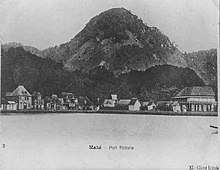
Independence
Independence was granted in 1976 and it became a republic at the same time. It has been a member of Commonwealth.[15] In the 1970s Seychelles was "the place to be seen, a playground for film stars and the international jet set".[16] In 1977, a coup d'état by France Albert René ousted the first president of the republic, James Mancham.[17] René discouraged overdependence on tourism and declared that he wanted "to keep the Seychelles for the Seychellois".[16]
The 1979 constitution declared a socialist one-party state, which lasted until 1991.
In the 1980s there were a series of coup attempts against President René, some of which were supported by South Africa. In 1981, Mike Hoare led a team of 43 South African mercenaries masquerading as holidaying rugby players in the 1981 Seychelles coup d'état attempt.[16] There was a gun battle at the airport, and most of the mercenaries later escaped in a hijacked Air India plane.[16] The leader of this hijacking was German mercenary D. Clodo, a former member of the Rhodesian SAS.[18] Clodo later stood trial in South Africa (where he was acquitted) as well as in his home country Germany for air piracy.[19]
In 1986, an attempted coup led by the Seychelles Minister of Defence, Ogilvy Berlouis, caused President René to request assistance from India. In Operation Flowers are Blooming, the Indian naval vessel INS Vindhyagiri arrived in Port Victoria to help avert the coup.[20]
The first draft of a new constitution failed to receive the requisite 60% of voters in 1992, but an amended version was approved in 1993.
In January 2013, Seychelles declared a state of emergency; the tropical cyclone Felleng caused torrential rain, and flooding and landslides destroyed hundreds of houses.[21][22]
Politics

The Seychelles president, who is head of state and head of government, is elected by popular vote for a five-year term of office. The cabinet is presided over and appointed by the president, subject to the approval of a majority of the legislature.
The unicameral Seychellois parliament, the National Assembly or Assemblée Nationale, consists of 34 members, 25 of whom are elected directly by popular vote, while the remaining nine seats are appointed proportionally according to the percentage of votes received by each party. All members serve five-year terms.
The Supreme Court of Seychelles, created in 1903, is the highest trial court in Seychelles and the first court of appeal from all the lower courts and tribunals. The highest court of law in Seychelles is the Seychelles Court of Appeal, which is the court of final appeal in the country.[23]
Political culture
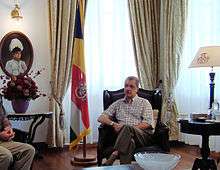
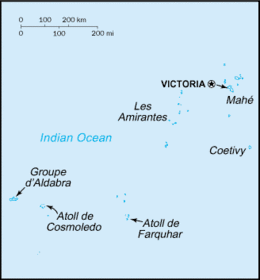
Seychelles' previous president France Albert René came to power after his supporters overthrew the first president James Mancham on 5 June 1977 in a coup d'état and installed him as president. René was at that time the prime minister.[24][25][26] René ruled as a strongman under a socialist one-party system until 1993, when he was forced to introduce a multi-party system. He stepped down in 2004 in favour of his vice-president, James Michel, who was reelected in 2006 and again in 2011.[24][25][26] On 28 September 2016, the Office of the President announced that Michel would step down effective 16 October, and that Vice President Danny Faure would complete the rest of Michel's term.[27]
The primary political parties are the ruling socialist People's Party (PP), known until 2009 as the Seychelles People's Progressive Front (SPPF) now called United Seychelles (US), and the socially liberal Seychelles National Party (SNP).[28]
Foreign relations
Seychelles is a member of the African Union (AU), the francophone Indian Ocean Commission (IOC), La Francophonie, the Southern African Development Community (SADC) and the Commonwealth. From 1979 to 1981, the United States was involved in the failed 1981 coup attempt.[29] Under the Obama administration, the US began running drone operations out of Seychelles.[30] In the Spring of 2013, members of the Special-Purpose Marine Air-Ground Task Force Africa mentored troops in Seychelles, along with a variety of other African nations.[30]
Administrative divisions
Seychelles is divided into twenty-six administrative regions comprising all of the inner islands. Eight of the districts make up the capital of Seychelles and are referred to as Greater Victoria. Another 14 districts are considered the rural part of the main island of Mahé with two districts on Praslin and one on La Digue which also includes respective satellite islands. The rest of the Outer Islands (Îles Eloignées) are the last district recently created by the tourism ministry.
|
Greater Victoria
|
Rural Mahé
|
Praslin
La Digue and remaining Inner Islands
|
Geography
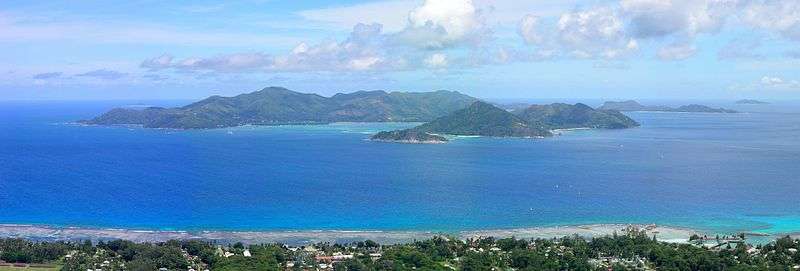
An island nation, Seychelles is located in the Somali Sea segment of the Indian Ocean, northeast of Madagascar and about 1,600 km (994 mi) east of Kenya. The Constitution of Seychelles lists 155 named islands and a further 7 reclaimed islands have been created subsequent to the publication of the Constitution. The majority of the islands are uninhabited, with many dedicated as nature reserves. Seychelles largest island Mahe is located at a distance of 835 mi (1,344 km), from Mogadishu, Somalia's capital over the Somali Sea.[31]
A group of 44 islands (42 granitic and 2 coralline) occupy the shallow waters of the Seychelles Bank and are collectively referred to as the inner islands. They have a total area of 244 km2, accounting for 54% of the total land area of the Seychelles and 98% of the entire population.
The islands are divided into groups as follows.
There are 42 granitic islands known as the Granitic Seychelles. These are in descending order of size: Mahé, Praslin, Silhouette Island, La Digue, Curieuse, Félicité, Frégate, Ste-Anne, North, Cerf, Marianne, Grand Sœur, Thérèse, Aride Island, Conception, Petite Sœur, Cousin Island, Cousine, Long, Récif, Round (Praslin), Anonyme, Mamelles, Moyenne, Île aux Vaches Marines, L'Islette, Beacon (Île Sèche), Cachée, Cocos, Round (Mahé), L'Ilot Frégate, Booby, Chauve-Souris (Mahé), Chauve-Souris (Praslin), Île La Fouche, Hodoul, L'Ilot, Rat, Souris, St. Pierre (Praslin), Zavé, Harrison Rocks (Grand Rocher).
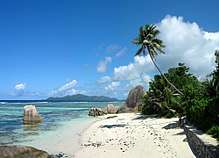
There are two coral sand cays north of the granitics on the edge of the Seychelles Bank: Denis and Bird.
There are two coral islands south of the Granitics: Coëtivy and Platte.
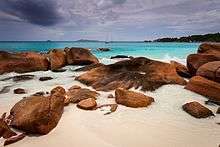
There are 29 coral islands in the Amirantes group, west of the granitics: Desroches, Poivre Atoll (comprising three islands—Poivre, Florentin and South Island), Alphonse, D'Arros, St. Joseph Atoll (comprising 14 islands—St. Joseph, Île aux Fouquets, Resource, Petit Carcassaye, Grand Carcassaye, Benjamin, Bancs Ferrari, Chiens, Pélicans, Vars, Île Paul, Banc de Sable, Banc aux Cocos and Île aux Poules), Marie Louise, Desnœufs, African Banks (comprising two islands—African Banks and South Island), Rémire, St. François, Boudeuse, Étoile, Bijoutier.
There are 13 coral islands in the Farquhar Group, south-southwest of the Amirantes: Farquhar Atoll (comprising 10 islands—Bancs de Sable, Déposés, Île aux Goëlettes, Lapins, Île du Milieu, North Manaha, South Manaha, Middle Manaha, North Island and South Island), Providence Atoll (comprising two islands—Providence and Bancs Providence) and St Pierre.
There are 67 raised coral islands in the Aldabra Group, west of the Farquhar Group: Aldabra Atoll (comprising 46 islands—Grande Terre, Picard, Polymnie, Malabar, Île Michel, Île Esprit, Île aux Moustiques, Ilot Parc, Ilot Émile, Ilot Yangue, Ilot Magnan, Île Lanier, Champignon des Os, Euphrate, Grand Mentor, Grand Ilot, Gros Ilot Gionnet, Gros Ilot Sésame, Héron Rock, Hide Island, Île aux Aigrettes, Île aux Cèdres, Îles Chalands, Île Fangame, Île Héron, Île Michel, Île Squacco, Île Sylvestre, Île Verte, Ilot Déder, Ilot du Sud, Ilot du Milieu, Ilot du Nord, Ilot Dubois, Ilot Macoa, Ilot Marquoix, Ilots Niçois, Ilot Salade, Middle Row Island, Noddy Rock, North Row Island, Petit Mentor, Petit Mentor Endans, Petits Ilots, Pink Rock and Table Ronde), Assumption Island, Astove and Cosmoledo Atoll (comprising 19 islands—Menai, Île du Nord (West North), Île Nord-Est (East North), Île du Trou, Goélettes, Grand Polyte, Petit Polyte, Grand Île (Wizard), Pagode, Île du Sud-Ouest (South), Île aux Moustiques, Île Baleine, Île aux Chauve-Souris, Île aux Macaques, Île aux Rats, Île du Nord-Ouest, Île Observation, Île Sud-Est and Ilot la Croix).
In addition to these 155 islands as per the Constitution of Seychelles there are 7 reclaimed islands: Ile Perseverance, Ile Aurore, Romainville, Eden Island, Eve, Ile du Port and Ile Soleil.
South Island, African Banks has been eroded by the sea. At St Joseph Atoll, Banc de Sable and Pelican Island have also eroded, while Grand Carcassaye and Petit Carcassaye have merged to form one island. There are also several unnamed islands at Aldabra, St Joseph Atoll and Cosmoledo. Pti Astove, though named, failed to make it into the Constitution for unknown reasons.
Climate
The climate is equable although quite humid, as the islands are small,[32] classified by Köppen-Geiger system as tropical rain forest (Af). The temperature varies little throughout the year. Temperatures on Mahé vary from 24 to 30 °C (75 to 86 °F), and rainfall ranges from 2,900 mm (114 in) annually at Victoria to 3,600 mm (142 in) on the mountain slopes. Precipitation is somewhat less on the other islands.[33]
During the coolest months, July and August, the average low is about 24 °C (75 °F). The southeast trade winds blow regularly from May to November, and this is the most pleasant time of the year. The hot months are from December to April, with higher humidity (80%). March and April are the hottest months, but the temperature seldom exceeds 31 °C (88 °F). Most of the islands lie outside the cyclone belt, so high winds are rare.[33]
| Climate data for Victoria (Seychelles International Airport) | |||||||||||||
|---|---|---|---|---|---|---|---|---|---|---|---|---|---|
| Month | Jan | Feb | Mar | Apr | May | Jun | Jul | Aug | Sep | Oct | Nov | Dec | Year |
| Average high °C (°F) | 29.8 (85.6) |
30.4 (86.7) |
31.0 (87.8) |
31.4 (88.5) |
30.5 (86.9) |
29.1 (84.4) |
28.3 (82.9) |
28.4 (83.1) |
29.1 (84.4) |
29.6 (85.3) |
30.1 (86.2) |
30.0 (86.0) |
29.8 (85.6) |
| Daily mean °C (°F) | 26.8 (80.2) |
27.3 (81.1) |
27.8 (82.0) |
28.0 (82.4) |
27.7 (81.9) |
26.6 (79.9) |
25.8 (78.4) |
25.9 (78.6) |
26.4 (79.5) |
26.7 (80.1) |
26.8 (80.2) |
26.7 (80.1) |
26.9 (80.4) |
| Average low °C (°F) | 24.1 (75.4) |
24.6 (76.3) |
24.8 (76.6) |
25.0 (77.0) |
25.4 (77.7) |
24.6 (76.3) |
23.9 (75.0) |
23.9 (75.0) |
24.2 (75.6) |
24.3 (75.7) |
24.0 (75.2) |
23.9 (75.0) |
24.4 (75.9) |
| Average precipitation mm (inches) | 379 (14.9) |
262 (10.3) |
167 (6.6) |
177 (7.0) |
124 (4.9) |
63 (2.5) |
80 (3.1) |
97 (3.8) |
121 (4.8) |
206 (8.1) |
215 (8.5) |
281 (11.1) |
2,172 (85.6) |
| Average precipitation days (≥ 1.0 mm) | 17 | 11 | 11 | 14 | 11 | 10 | 10 | 10 | 11 | 12 | 14 | 18 | 149 |
| Average relative humidity (%) | 82 | 80 | 79 | 80 | 79 | 79 | 80 | 79 | 78 | 79 | 80 | 82 | 79.8 |
| Mean monthly sunshine hours | 153.3 | 175.5 | 210.5 | 227.8 | 252.8 | 232.0 | 230.5 | 230.7 | 227.7 | 220.7 | 195.7 | 170.5 | 2,527.7 |
| Source 1: World Meteorological Organization[34] | |||||||||||||
| Source 2: National Oceanic and Atmospheric Administration[35] | |||||||||||||
Wildlife
Seychelles is among the world's leading countries to protect lands for threatened species, allocating 42% of its territory for conservation.[36] Like many fragile island ecosystems, Seychelles saw the loss of biodiversity when humans first settled in the area, including the disappearance of most of the giant tortoises from the granitic islands, the felling of coastal and mid-level forests, and the extinction of species such as the chestnut flanked white eye, the Seychelles parakeet, and the saltwater crocodile. However, extinctions were far fewer than on islands such as Mauritius or Hawaii, partly due to a shorter period of human occupation (since 1770). Seychelles today is known for success stories in protecting its flora and fauna. The rare Seychelles black parrot, the national bird of the country, is now protected.
The granitic islands of Seychelles are home to about 75 endemic plant species, with a further 25 or so species in the Aldabra group. Particularly well known is the coco de mer, a species of palm that grows only on the islands of Praslin and neighbouring Curieuse. Sometimes nicknamed the "love nut" because the shape of its "double" coconut resembles buttocks, the coco-de-mer produces the world's heaviest seed. The jellyfish tree is to be found in only a few locations on Mahe. This strange and ancient plant in a genus of its own (Medusagyne) seems to reproduce only in cultivation and not in the wild. Other unique plant species include Wright's gardenia (Rothmannia annae) found only on Aride Island Special Reserve.
The freshwater crab genus Seychellum is endemic to the granitic Seychelles, and a further 26 species of crabs and five species of hermit crabs live on the islands.[37]
The Aldabra giant tortoise now populates many of the islands of Seychelles; the Aldabra population is the largest remaining. These unique reptiles can be found even in captive herds. The granitic islands of Seychelles may support distinct species of Seychelles giant tortoises; the status of the different populations is currently unclear.
There are several unique species of orchid on the islands.
Seychelles hosts some of the largest seabird colonies in the world, notably on the outer islands of Aldabra and Cosmoledo. In granitic Seychelles the largest colonies are on Aride Island including the world's largest numbers of two species. Sooty terns also breed on the islands. Other birds include Cattle egrets (Bubulcus ibis) and Fairy terns (Gygis alba).[38]
The marine life around the islands, especially the more remote coral islands, can be spectacular. More than 1,000 species of fish have been recorded.
Environmental issues
Since the use of spearguns and dynamite for fishing was banned through efforts of local conservationists in the 1960s, the wildlife is unafraid of snorkelers and divers. Coral bleaching in 1998 has damaged most reefs, but some reefs show healthy recovery (e.g., Silhouette Island).
Despite huge disparities across nations, Seychelles claims to have achieved nearly all of its Millennium Development Goals.[39] 17 MDGS and 169 targets have been achieved. Environmental protection is becoming a cultural value.
Their government's Seychelles Climate Guide describes the nation's climate as rainy, with a dry season with an ocean economy in the ocean regions. The Southeast Trades is on the decline but still fairly strong.[40] Reportedly, weather patterns there are becoming less predictable.[41]
Demographics
When the British gained control of the islands during the Napoleonic Wars, they allowed the French upper class to retain their land. Both the French and British settlers used enslaved Africans, and although the British prohibited slavery in 1835, African workers continued to come. Thus the Gran blan ("big whites") of French origin dominated economic and political life. The British administration employed Indians on indentured servitude to the same degree as in Mauritius resulting in a small Indian population. The Indians, like a similar minority of Chinese, were confined to a merchant class.[42]
Through harmonious socioeconomic policies and developments over the years, today Seychelles is described as a fusion of peoples and cultures. Numerous Seychellois are considered multiracial: blending from African, Asian and European descent to create a modern creole culture. Evidence of this harmonious blend is also revealed in Seychellois food, incorporating various aspects of French, Chinese, Indian and African cuisine.
As the islands of the Seychelles had no indigenous population, the current Seychellois descend from people who immigrated, of which the largest ethnic groups were those of African, French, Indian and Chinese origin. The median age of the Seychellois is 32 years.[43]
Languages
French and English are official languages along with Seychellois Creole, which is primarily based upon French. However, nowadays the language is often laced with English words and phrases. Including second-language speakers, Seychellois Creole is the most-spoken official language in the Seychelles, followed by French and English.[44] 91% of the population speaks Seychelles Creole, 5.1% speaks English and 0.7 % French.[44] Most business and official meetings are conducted in English and nearly all official websites are in English. National Assembly business is conducted in Creole, but laws are passed and published in English.
Religion

According to the 2010 census, most Seychellois are Christians: 76.2% were Roman Catholic, pastorally served by the exempt Diocese of Port Victoria or Seychelles (immediately dependent on the Holy See); 10.6% were Protestant, (Anglican 6.1%, Pentecostal Assembly 1.5%, Seventh-Day Adventist 1.2%, other Protestant 1.6%).[45]
Hinduism is the second largest religion, with more than 2.4% of the population.[43] The Hindu following in Seychelles has seen an increase in the community with the organization of the Seychelles Hindu Kovil Sangam and the consecration of the Navasakti Vinayagar Temple.A reported 6% of the population of Seychelles are ethnic Indians, but only 2.4% are Hindus.
Islam is followed by another 1.6% of the population. Other faiths accounted for 1.1% of the population, while a further 5.9% were non-religious or did not specify a religion.[43]
Economy
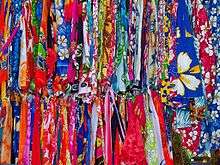
During the plantation era, cinnamon, vanilla and copra were the chief exports. In 1965, during a three-month visit to the islands, futurist Donald Prell prepared for the then-crown colony Governor General an economic report containing a scenario for the future of the economy. Quoting from his report, in the 1960s, about 33% of the working population worked at plantations, and 20% worked in the public or government sector.[46][47] The Indian Ocean Tracking Station on Mahé used by the Air Force Satellite Control Network was closed in August 1996 after the Seychelles government attempted to raise the rent to more than $10,000,000 per year.
Since independence in 1976, per capita output has expanded to roughly seven times the old near-subsistence level. Growth has been led by the tourist sector, which employs about 30% of the labour force, compared to agriculture which today employs about 3% of the labour force. Despite the growth of tourism, farming and fishing continue to employ some people, as do industries that process coconuts and vanilla.
As of 2013, the main export products are processed fish (60%) and non-fillet frozen fish (22%).[48]
The prime agricultural products currently produced in Seychelles include sweet potatoes, vanilla, coconuts and cinnamon. These products provide much of the economic support of the locals. Frozen and canned fish, copra, cinnamon and vanilla are the main export commodities.
Since the worldwide economic crises of 2008, the Seychelles government has prioritised a curbing of the budget deficit, including the containment of social welfare costs and further privatisation of public enterprises. The government has a pervasive presence in economic activity, with public enterprises active in petroleum product distribution, banking, imports of basic products, telecommunications and a wide range of other businesses. According to the 2013 Index of Economic Freedom, which measures the degree of limited government, market openness, regulatory efficiency, rule of law, and other factors, economic freedom has been increasing each year since 2010.[49]
The national currency of Seychelles is the Seychellois rupee. Initially tied to a basket of international currencies, it was depegged and allowed to be devalued and float freely in 2008 on the presumed hopes of attracting further foreign investment in the Seychelles economy.
Tourism
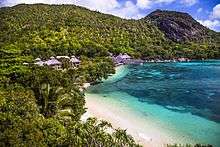
In 1971, with the opening of Seychelles International Airport, tourism became a significant industry, essentially dividing the economy into plantations and tourism. The tourism sector paid better, and the plantation economy could only expand so far. The plantation sector of the economy declined in prominence, and tourism became the primary industry of Seychelles.
In recent years the government has encouraged foreign investment to upgrade hotels and other services. These incentives have given rise to an enormous amount of investment in real estate projects and new resort properties, such as project TIME, distributed by the World Bank, along with its predecessor project MAGIC. Despite its growth, the vulnerability of the tourist sector was illustrated by the sharp drop in 1991–1992 due largely to the Gulf War.[50]
Since then the government has moved to reduce the dependence on tourism by promoting the development of farming, fishing, small-scale manufacturing and most recently the offshore financial sector, through the establishment of the Financial Services Authority and the enactment of several pieces of legislation (such as the International Corporate Service Providers Act, the International Business Companies Act, the Securities Act, the Mutual Funds and Hedge Fund Act, amongst others). In March 2015, Seychelles allocated Assumption Island to be developed by India.[51]
Energy
Although multinational oil companies have explored the waters around the islands, no oil or gas has been found. In 2005, a deal was signed with US firm Petroquest, giving it exploration rights to about 30,000 km2 around Constant, Topaz, Farquhar and Coëtivy islands until 2014. Seychelles imports oil from the Persian Gulf in the form of refined petroleum derivatives at the rate of about 5,700 barrels per day (910 m3/d).
In recent years oil has been imported from Kuwait and also from Bahrain. Seychelles imports three times more oil than is needed for internal uses because it re-exports the surplus oil in the form of bunker for ships and aircraft calling at Mahé. There are no refining capacities on the islands. Oil and gas imports, distribution and re-export are the responsibility of Seychelles Petroleum (Sepec), while oil exploration is the responsibility of the Seychelles National Oil Company (SNOC).
Culture
For such a small country, Seychelles has a vibrant art scene that encompasses painters, sculptors, writers and poets, artisans of many types, musicians and dancers.
Art
The Seychelles has a diverse and upcoming group of artists who draw inspiration from the Islands around them.
A National Art Gallery was inaugurated in 1994 on the occasion of the official opening of the National Cultural Centre which housed the National Library and the National Archives with other offices of the Ministry of Culture.
The Minister of Culture then said that an exhibition which featured the works of artists, painters and sculptors was a testimony to the development of art in Seychelles as a creative form of expression and gave a view of the state of contemporary art in Seychelles.
Contemporary Seychelles’ artists trained in universities the world over since the independence of the country in 1976, particularly, have been free to express themselves in a variety of styles.
Painters have traditionally taken inspiration from the richness of Seychelles’ natural beauty to produce a wide range of works using mediums ranging from water-colours to oils, acrylics, collages, metals, aluminium, wood, fabrics, gouache, varnishes, recycled materials, pastels, charcoal, embossing, etching, and giclee prints. Local sculptors produce fine works in wood, stone, bronze and cartonnage.
Art in Seychelles, Then and Now’ Is a recently published hardback that provides a unique overview of both contemporary art in Seychelles as well as exploring aspects of the history and development of visual art.
Fifty artists collaborated in the project through interview and the provision of work which collectively articulates an energised and increasingly diverse range of outcomes.
Generously illustrated in colour, the book annotates the work of practicing artists through their own words and provides a narrative timeline dating back to the first habitation of the islands in the 18th century.
Music
Music and dance have always played a prominent role in Seychelles culture and in all types of local festivities. Rooted in African, Malagasy and European cultures, music is played to the accompaniment of drums such as the Tambour and Tam-Tam and simple string instruments. The violin and guitar are relatively recent foreign imports which play a prominent role in today's music.
The lively Sega dance with its elegant hip-swaying and shuffling of the feet is still popular as is the traditional Moutya, a mysterious, dance dating back to the days of slavery when it was often used as an outlet for strong emotions and as a way of expressing discontent.
The music of Seychelles is diverse, a reflection of the fusion of cultures through its history. The folk music of the islands incorporates multiple influences in a syncretic fashion, including African rhythms, aesthetic and instrumentation—such as the zez and the bom (known in Brazil as berimbau), European contredanse, polka and mazurka, French folk and pop, sega from Mauritius and Réunion, taarab, soukous and other pan-African genres, and Polynesian, Indian and Arcadian music.
A form of percussion music called contombley is popular, as is Moutya, a fusion of native folk rhythms with Kenyan benga. Kontredans (based on European contredanse) is popular, especially in District and School competitions during the annual Festival Kreol (International Creole Festival). Moutya playing and dancing can often be seen at beach bazaars. Their main languages are Seychellois Creole of the French language, French and English.
Cuisine

Staple foods include fish, seafood and shellfish dishes, often accompanied with rice.[52][53] Fish dishes are cooked in several ways, such as steamed, grilled, wrapped in banana leaves, baked, salted and smoked.[52] Curry dishes with rice are also a significant aspect of the country's cuisine.[53][54]
Additional food staples include coconut, breadfruit, mangoes and kordonnyen fish.[55] Dishes are often garnished with fresh flowers.[55]
- Chicken dishes, such as chicken curry and coconut milk.[53]
- Coconut curry[53]
- Dhal (lentils)[55]
- Fish curry[53]
- Saffron rice[55]
- Fresh tropical fruits[52][56]
- Ladob is eaten either as a savoury dish or as a dessert. The dessert version usually consists of ripe plantain and sweet potatoes (but may also include cassava, breadfruit or even corossol) boiled with coconut milk, sugar, nutmeg and vanilla in the form of a pod until the fruit is soft and the sauce is creamy.[57] The savoury dish usually includes salted fish, cooked in a similar fashion to the dessert version, with plantain, cassava and breadfruit, but with salt used in place of sugar (and omitting vanilla).
- Shark chutney typically consists of boiled skinned shark, finely mashed, and cooked with squeezed bilimbi juice and lime. It is mixed with onion and spices, and the onion is fried and it is cooked in oil.[57]
- Vegetables[53][56]
The main daily newspaper is the Seychelles Nation, dedicated to local government views and current affairs and topics. Other political parties operate other papers such as Regar. Foreign newspapers and magazines are readily available in most bookshops and newsagents. The papers are mostly written in Seychellois Creole, French and English.
The main television and radio network is operated by the Seychelles Broadcasting Corporation which offers locally produced news and discussion programmes in the Seychellois Creole language. Broadcasts run between 3 pm and 11:30 pm on weekdays and longer hours during the weekends. There are also imported English and French language television programmes imported on Seychellois terrestrial television and international satellite television has grown rapidly in recent years.
Sports
The most popular sport in Seychelles is basketball, which has particularly developed last decade.[58] The country's national team qualified for the 2015 African Games, its greatest accomplishment to date. There, the team competed against some of the continent's largest countries such as Egypt.
Women
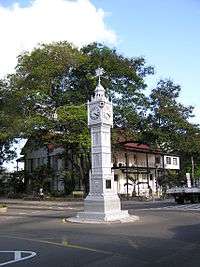
Seychellois society is essentially matriarchal.[59][60] Mothers tend to be dominant in the household, controlling most expenditures and looking after the interests of the children.[59] Unwed mothers are the societal norm, and the law requires fathers to support their children.[60] Men are important for their earning ability, but their domestic role is relatively peripheral.[59]
Education
Until the mid-19th century, little formal education was available in Seychelles. The Catholic and Anglican churches opened mission schools in 1851. The Catholic mission later operated boys' and girls' secondary schools with religious brothers and nuns from abroad even after the government became responsible for them in 1944.
A teacher training college opened in 1959, when the supply of locally trained teachers began to grow, and in short time many new schools were established. Since 1981 a system of free education has been in effect, requiring attendance by all children in grades one to nine, beginning at age five. Ninety percent of all children attend nursery school at age four.
The literacy rate for school-age children rose to more than 90% by the late 1980s. Many older Seychellois had not been taught to read or write in their childhood; adult education classes helped raise adult literacy from 60% to a claimed 100% in 2014.
There are a total of 68 schools in Seychelles. The public school system consists of 23 crèches, 25 primary schools and 13 secondary schools. They are located on Mahé, Praslin, La Digue and Silhouette. Additionally, there are three private schools: École Française, International School and the independent school. All the private schools are on Mahé, and the International School has a branch on Praslin. There are seven post-secondary (non-tertiary) schools: the Seychelles Polytechnic, School of Advanced Level Studies, Seychelles Tourism Academy, University of Seychelles Education, Seychelles Institute of Technology, Maritime Training Center, Seychelles Agricultural and Horticultural Training Center and the National Institute for Health and Social Studies.
The administration launched plans to open a university in an attempt to slow down the brain drain that has occurred. University of Seychelles, initiated in conjunction with the University of London, opened on 17 September 2009 in three locations, and offers qualifications from the University of London.
Security
Military
The Military of Seychelles is the Seychelles People's Defence Force which consists of a number of distinct branches: an Infantry Unit and Coast Guard, Air Force and a Presidential Protection Unit. India has played and continues to play a key role developing the military of Seychelles. After handing over two SDB Mk5 patrol vessels built by GRSE, the INS Tarasa and INS Tarmugli, to the Seychelles Coast Guard, which were subsequently renamed SCG Constant and SCG Topaz, India also gifted a Dornier Maritime Patrol aircraft built by Hindustan Aeronautics Limited.[61] India also signed a pact to develop Assumption Island, one of the 115 islands that make up the country. Spread over 11 km2 (4 sq mi), it is strategically located in the Indian Ocean, north of Madagascar. The island is being leased for the development of strategic assets by India.[62] In 2018, Seychelles signed the UN treaty on the Prohibition of Nuclear Weapons.[63][64]
Incarceration
In 2014, Seychelles had the highest incarceration rate in the world of 799 prisoners per 100,000 population, exceeding the United States' rate by 15%.[65] However, the country's actual population is less than 100,000; as of September 2014, Seychelles had 735 actual prisoners, 6% of whom were female, incarcerated in three prisons.[66]
Modern piracy
Seychelles is a key participant in the fight against Indian Ocean piracy primarily committed by Somali pirates.[67] Former president James Michel said that piracy costs between $7 million – $12 million a year to the international community: "The pirates cost 4% of the Seychelles GDP, including direct and indirect costs for the loss of boats, fishing, and tourism, and the indirect investment for the maritime security." These are factors affecting local fishing – one of the country's main national resources – which had a 46% loss in 2008–2009.[67] International contributions of patrol boats, planes or drones have been provided to help Seychelles combat sea piracy.[67]
References
- "Archived copy" (PDF). Archived from the original (PDF) on 14 May 2014. Retrieved 26 April 2015.CS1 maint: archived copy as title (link)
- ""World Population prospects – Population division"". population.un.org. United Nations Department of Economic and Social Affairs, Population Division. Retrieved 9 November 2019.
- ""Overall total population" – World Population Prospects: The 2019 Revision" (xslx). population.un.org (custom data acquired via website). United Nations Department of Economic and Social Affairs, Population Division. Retrieved 9 November 2019.
- "Seychelles". International Monetary Fund. Archived from the original on 10 October 2017. Retrieved 8 June 2017.
- "GINI index". World Bank. Archived from the original on 21 January 2018. Retrieved 20 January 2018.
- "2019 Human Development Report" (PDF). United Nations Development Programme. 2019. Retrieved 9 December 2019.
- "Seychelles - English translation in German - Langenscheidt dictionary French-German" (in English, German, and French). Retrieved 29 December 2018.
- "Traduction : Seychelles - Dictionnaire français-anglais Larousse" (in English and French). Retrieved 29 December 2018.
- "Seychelles | French » English | PONS" (in English and French). Retrieved 29 December 2018.
- "English Translation of "Seychelles" | Collins French-English Dictionary" (in English and French). Retrieved 29 December 2018.
- Anouk Zijlma (9 July 2011). "Facts about Africa". Goafrica.about.com. Archived from the original on 4 March 2012. Retrieved 23 March 2012.
- "Seychelles – Income Inequality – GINI index". Knoema, World Data Atlas. 2013. Archived from the original on 10 August 2017. Retrieved 11 July 2017.
- Lionnet, Guy (1972). The Seychelles. David and Charles. pp. 55–56. ISBN 978-0811715140.
- "Our History". National Assembly of Seychelles. Archived from the original on 28 June 2012. Retrieved 12 May 2012.
- "History of Seychelles". seychelles.com. 2009. Archived from the original on 8 June 2010. Retrieved 9 September 2010.
- Joanna Symons (21 March 2005). "Seychelles: Life's a breeze near the equator" Archived 4 May 2018 at the Wayback Machine. Telegraph.co.uk.
- "africanhistory.about.com". africanhistory.about.com. Archived from the original on 14 March 2012. Retrieved 23 March 2012.
- Hoare, Mike The Seychelles Affair (Transworld, London, 1986; ISBN 0-593-01122-8)
- Bartus László: Maffiaregény ISBN 9634405967, Budapest 2001
- David Brewster and Ranjit Rai. "Flowers Are Blooming: the story of the India Navy's secret operation in the Seychelles. Retrieved 10 August 2014". Archived from the original on 7 June 2015. Retrieved 11 August 2014. Cite journal requires
|journal=(help) - "International Chapter activated for flooding in the Republic of Seychelles". United Nation. Archived from the original on 3 February 2013. Retrieved 1 February 2013.
- "State of Emergency declared in the Seychelles". Aljazeera. Archived from the original on 30 January 2013. Retrieved 1 February 2013.
- "The Judiciary". Bar Association of Seychelles. Archived from the original on 1 March 2016. Retrieved 18 February 2016.
- "Results reflect popular will, observers say". Seychelles Nation. Archived from the original on 28 September 2011. Retrieved 30 May 2011.
- "Seychelles re-elects President Michel". Reuters. 21 May 2011. Archived from the original on 25 July 2012. Retrieved 23 May 2011.
- "Vote buying claims mar Seychelles election". Agence France-Presse. 19 May 2011. Archived from the original on 25 May 2012.
- George Thande (28 September 2016). "Seychelles vice president to complete term of resigning president". Reuters. Archived from the original on 29 September 2016. Retrieved 28 September 2016.
- "Seychellen4you – Seychelles Info". www.seychelles4u.com (in German). Archived from the original on 22 March 2017. Retrieved 21 March 2017.
- Thomson, Andrew (2018). Outsourced Empire: How Militias, Mercenaries, and Contractors Support US Statecraft. London: Pluto Press. p. 41. ISBN 978-0-7453-3703-6.
- Turse, Nick (2015). Tomorrow's Battlefield: US Proxy Wars and Secret Ops in Africa. Chicago: Haymarket Books. pp. 13, 55. ISBN 978-1-60846-463-0.
- Werema, Gilbert. "Safeguarding Tourism and Tuna: Seychelles’ Fight against the Somali Piracy Problem." (2012).
- U.S. Department of State. "Background Note: Seychelles". Retrieved 25 May 2010. This article incorporates text from this source, which is in the public domain.
- "Climate". STGT.com. Archived from the original on 6 March 2012. Retrieved 23 March 2012.
- "World Weather Information Service – Victoria". World Meteorological Organization. Archived from the original on 13 March 2013. Retrieved 16 November 2012.
- "SEYCHELLES INTL AP Climate Normals 1971–1990". National Oceanic and Atmospheric Administration. Retrieved 16 November 2012.
- "Mapped: The countries with the most protected land (#1 might surprise you)". The Telegraph. Archived from the original on 23 February 2018. Retrieved 7 February 2018.
- Janet Haig (1984). "Land and freshwater crabs of the Seychelles and neighbouring islands". In David Ross Stoddart (ed.). Biogeography and Ecology of the Seychelles Islands. Springer. p. 123. ISBN 978-90-6193-107-2.
- Attenborough, D. 1998.The Life of Birds. p.220-221. BBC. ISBN 0563-38792-0
- "Seychelles Millennium Development Goals: Status Report 2010" (PDF). United Nations Development Programme. August 2010. Archived (PDF) from the original on 29 October 2018. Retrieved 29 October 2018.
- Seychelles Climate Guide, 2015. Ministry of Environment, Energy and Climate Change. meteo.gov.sc
- Seychelles weather and climate, see 'Blue Economy' Archived 26 September 2015 at the Wayback Machine. Expertafrica.com. Retrieved on 8 December 2016.
- "Culture of Seychelles". Everyculture.com. Archived from the original on 22 April 2012. Retrieved 23 March 2012.
- "Seychelles". CIA – The World Factbook. Archived from the original on 13 February 2008. Retrieved 27 May 2007.
- Lewis, M. Paul, Gary F. Simons, and Charles D. Fennig (eds.) (2016). "Seychelles languages". Ethnologue: Languages of the World, Dallas, Texas; 19th edition. Archived from the original on 3 November 2016. Retrieved 2 November 2016.CS1 maint: multiple names: authors list (link) CS1 maint: extra text: authors list (link)
- "Archived copy" (PDF). Archived from the original (PDF) on 14 May 2014. Retrieved 18 March 2020.CS1 maint: archived copy as title (link)
- D. B. Prell (1965). Economic Study of the Seychelles Islands. D.B. Prell.
- Economic. Study. Seychelles. 1965. D. B. Prell. Internet Archive. 1965.
- OEC – Products exported by the Seychelles (2013) Archived 21 August 2016 at the Wayback Machine. Atlas.media.mit.edu. Retrieved on 8 December 2016.
- "2013 Index of Economic Freedom". The Heritage Foundation. Archived from the original on 8 July 2013. Retrieved 23 August 2013.
- "Seychelles economy – Seychelles Travel Guide". Seychellestour.com. Archived from the original on 2 March 2012. Retrieved 23 March 2012.
- India to develop two islands in Indian Ocean – Times of India Archived 15 March 2015 at the Wayback Machine. Timesofindia.indiatimes.com (11 March 2015). Retrieved on 8 December 2016.
- Lonely Planet Mauritius, Reunion & Seychelles. Lonely Planet. 2010. pp. 273–274. ISBN 978-1-74179-167-9.
- Dyfed Lloyd Evans. The Recipes of Africa. Dyfed Lloyd Evans. pp. 235–236.
- Practice Tests for IGCSE English as a Second Language Reading and Writing. Cambridge University Press. 4 February 2010. p. 50. ISBN 978-0-521-14059-1.
- Paul Tingay (2006). Seychelles. New Holland Publishers. pp. 33–34. ISBN 978-1-84537-439-6.
- Lloyd E. Hudman; Richard H. Jackson (2003). Geography of Travel and Tourism. Cengage Learning. p. 384. ISBN 978-0-7668-3256-5.
- Sarah Carpin (1998) Seychelles, Odyssey Guides, The Guidebook Company Limited. p. 77
- Seychelles Basketball Federation eager to grow sport's popularity Archived 7 August 2016 at the Wayback Machine, Fiba.com, 12 May 2016. Retrieved 8 June 2016.
- Tartter, Jean R. "Status of Women". Indian Ocean country studies: Seychelles Archived 11 December 2005 at the Wayback Machine (Helen Chapin Metz, editor). Library of Congress Federal Research Division (August 1994). This article incorporates text from this source, which is in the public domain.
- Country Reports on Human Rights Practices: Seychelles (2007) Bureau of Democracy, Human Rights, and Labor (11 March 2008). This article incorporates text from this source, which is in the public domain.
- "India gifts second fast attack craft INS Tarasa to the Seychelles Coast Guard" Archived 2 April 2015 at the Wayback Machine. Times of India. 8 November 2014
- Shubhajit Roy (12 March 2015) "India to develop strategic assets in 2 Mauritius, Seychelles islands" Archived 11 March 2015 at the Wayback Machine. The Indian Express.
- "Chapter XXVI: Disarmament – No. 9 Treaty on the Prohibition of Nuclear Weapons". United Nations Treaty Collection. 7 July 2017.
- "President of Seychelles signs treaty banning nuclear weapons, meets with leaders at UN". Seychelles News Agency. 27 September 2018.
- "Highest to Lowest – Prison Population Rates Across the World". World Prison Brief. 2014. Archived from the original on 11 November 2016. Retrieved 22 October 2016.
- "Data for prison population in Seychelles". World Prison Brief. 2014. Archived from the original on 7 November 2016. Retrieved 22 October 2016.
- Colonnello, Paolo (6 March 2012). "A Pirate's Prison Tucked Inside Seychelles Paradise". Worldcrunch. Archived from the original on 17 October 2016. Retrieved 22 October 2016.
External links
Government
- SeyGov, main government portal
- State House, Office of the President of the Republic of Seychelles
- Central Bank of Seychelles, on-shore banking and insurance regulator
- Seychelles Investment Bureau, government agency promoting investment in Seychelles
- National Bureau of Statistics, government agency responsible for collecting, compiling, analysing and publishing statistical information
Religion
General
- "Seychelles". The World Factbook. Central Intelligence Agency.
- Seychelles from UCB Libraries GovPubs
- Seychelles at Curlie
- Seychelles from BBC News

- Island Conservation Society, a non-profit nature conservation and educational non-governmental organisation
- Nature Seychelles, a scientific/environmental non-governmental nature protection association
- The Seychelles Nation, the largest circulation local daily newspaper
- Seychelles Bird Records Committee
- Seychelles.travel, Government tourism portal
- Tourism Page
- Air Seychelles, Seychelles national airline
- ADST interview with U.S. Ambassador to Seychelles David Fischer
- Private website with tips and images
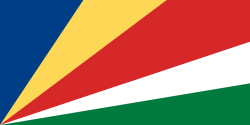
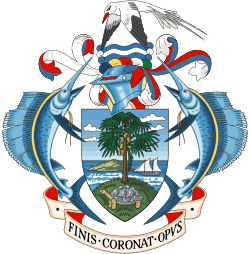
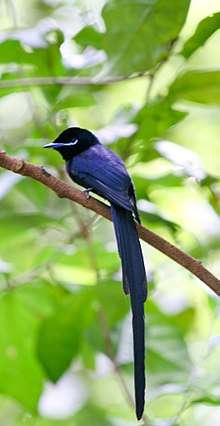
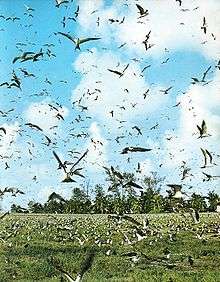
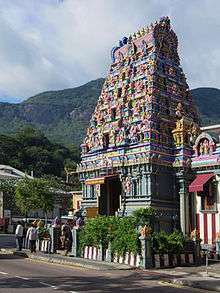
.svg.png)
